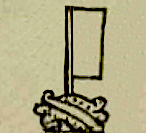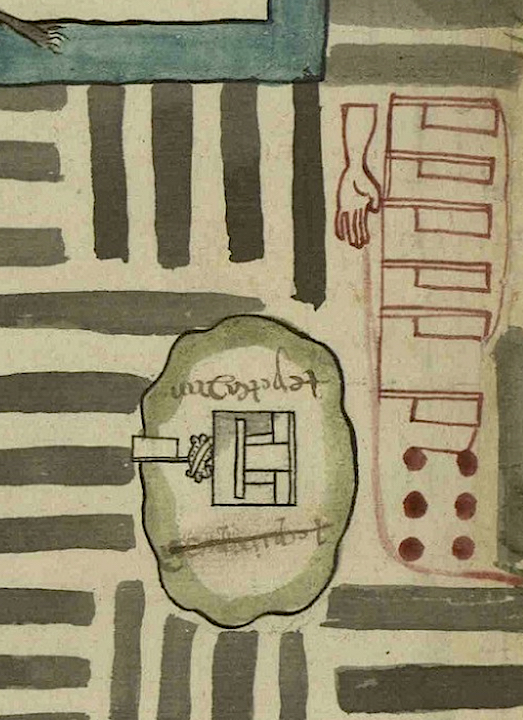Tepetlapan (T2681:6:2r)
This is a compound glyph naming the community of Tepetlapan in the Chalco region of the Valley of Mexico. It consists of two elements, one a logogram for tepetlatl), a type of porous volcanic stone, and a phonetic locative element, -pan (on, at, etc.) represented by a banner (panitl). The right-facing banner projects upwards from the horizontal stone. These elements are outlined in black and have no shading. The stone, however, is dotted to indicate its porous nature. It has a diagonal band with curled ends running along its length.
Robert Haskett
The tiny dots on the stone are what make it look porous. This is reminiscent of the glyph for Tepoxaco, which shows a stone with dots surrounding it.
This compound glyph appears on a mapa submitted by Indigenous petitioners from the pueblo of Cuitlahuacan, Chalco, sometime before March 24, 1579, when a canoe-born investigation was carried out of a chinampa (artificially constructed raised field in the shallow waters of a laguna) near the sujeto (dependency) of Santa María Magdalena Michcalco (also called an estançia). Tepetlapan was another sujeto in the area an appears on the same map (see the historical contextualizing image). According to the petitioners, a man named Bartolomé Arias was attempting to gain a property grant from the viceregal authorities that would compromise indigenous land tenure (an effort that ultimately failed). Contextually, the glyph for Tepetlapan is placed on the flat of a building (calli) in frontal view, which in turn is sited on a black-outlined oval figure—with a band of green shading inside running around the boundary—that might indicate an island (a similar element on the map lacks any other features, but is glossed as tierras as opposed to the chinampa elments, which are glossed as camellones, or "ridges"). Whatever the case, it seems to be a semantic indicator for a place, complemented a second such element, the house, indicating that this is an inhabited place (see the historical contextualizing image). An alphabetic gloss of the place name is written next to the right wall of the house; there is a second alphabetic gloss on the other side which has been crossed out.
Robert Haskett
tepetlapan
Tepetlapan
Robert Haskett
1579
Robert Haskett
volcanic stone, tepetate, locative

tepetla(tl), porous volcanic stone used in construction, https://nahuatl.wired-humanities.org/content/tepetlatl
-pan, a locative meaning on, at, over, on top of, with, https://nahuatl.wired-humanities.org/content/pan
pan(itl), banner, flag, https://nahuatl.wired-humanities.org/content/panitl
En el tepetate
Robert Haskett
Single-page codex, Archivo General de la Nación, México, Ramo de Tierras Vol. 2681, Exp. 6, Fol. 2r.
The Archivo General de la Nación (AGN), México, holds the original manuscript. This image is published here under a Creative Commons license, asking that you cite the AGN and this Visual Lexicon of Aztec Hieroglyphs.





